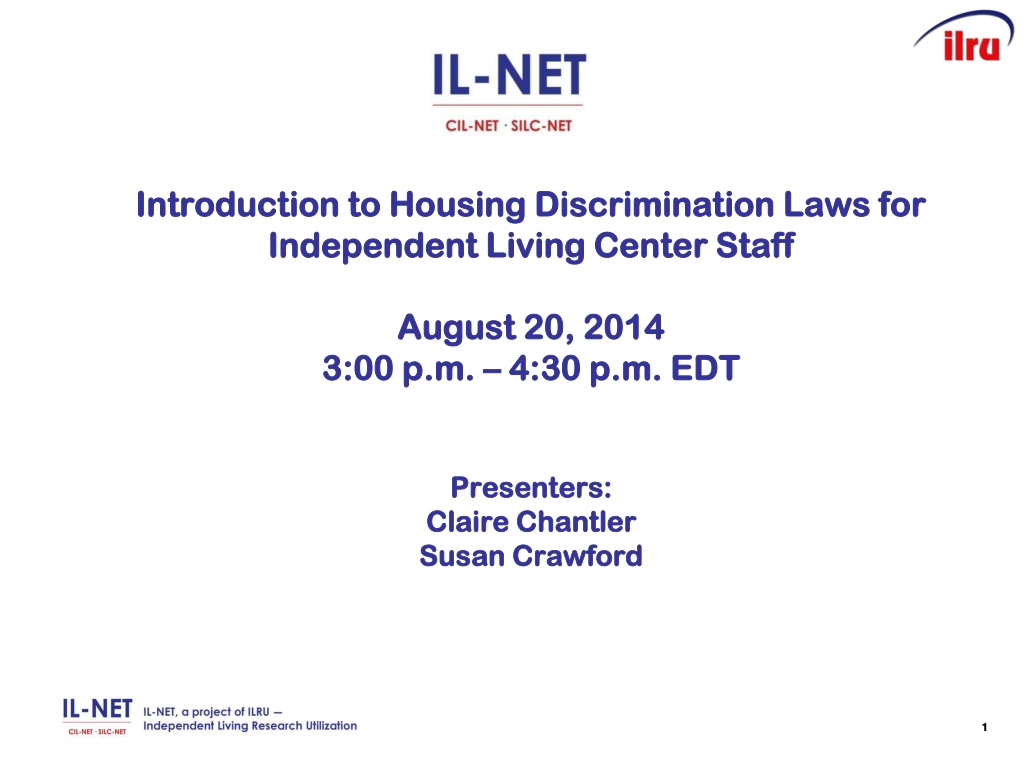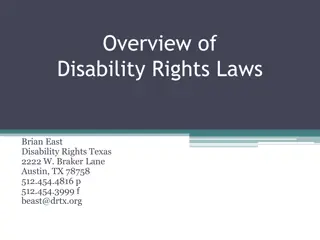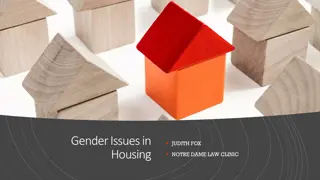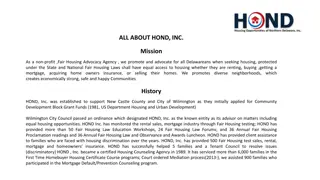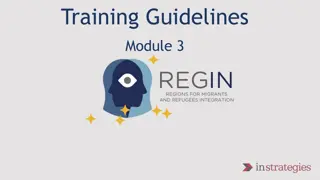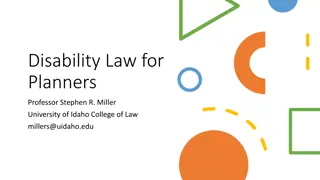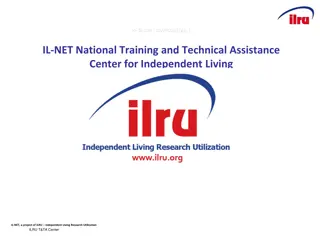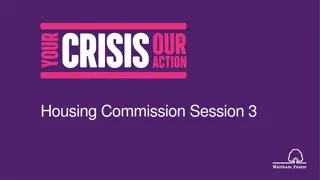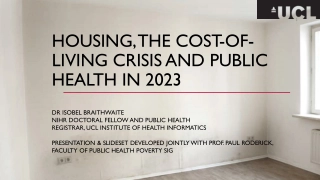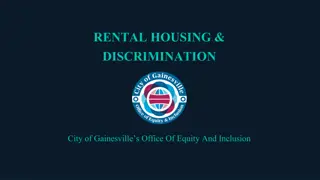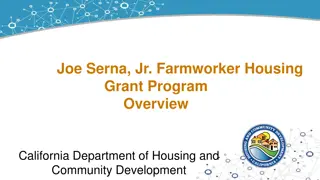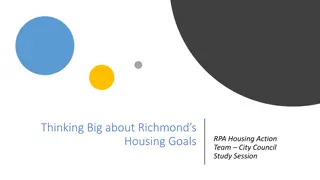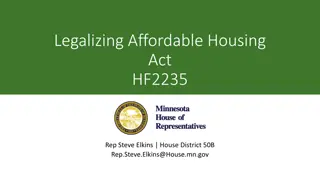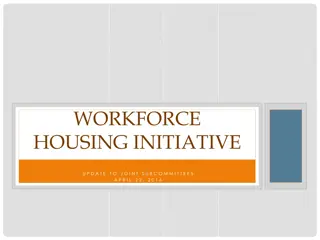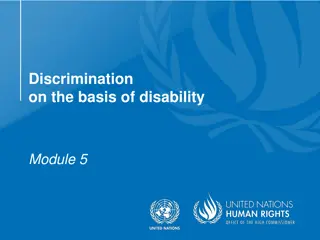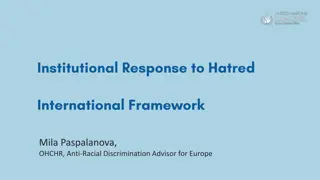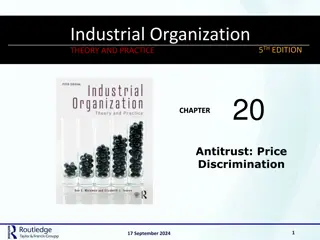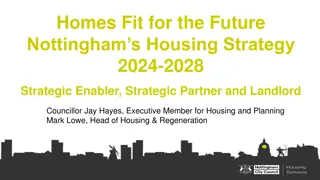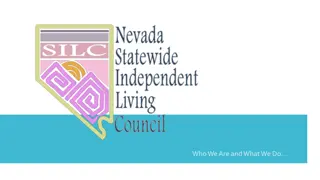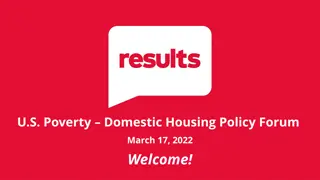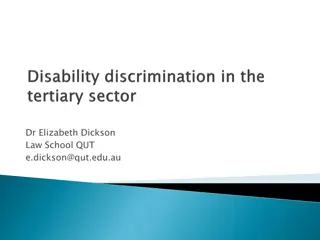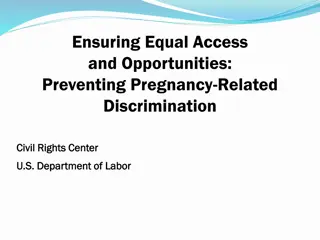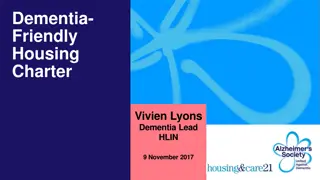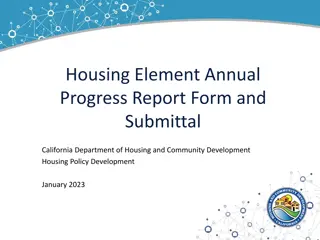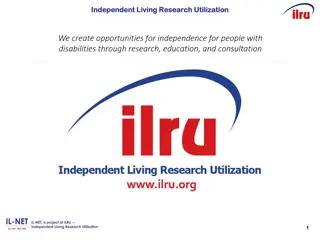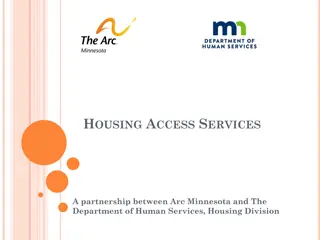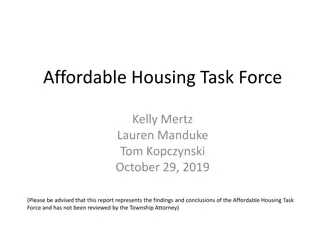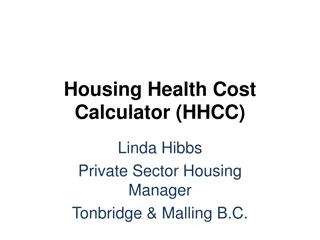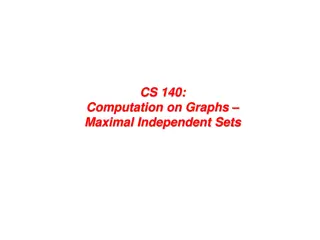Understanding Housing Discrimination Laws for Independent Living Centers
This presentation covers key housing discrimination laws applicable to independent living center staff, including the Fair Housing Act, Section 504 of the Rehabilitation Act of 1973, and Title II of the Americans with Disabilities Act. It delves into the protections against discrimination based on race, color, national origin, religion, sex, familial status, and disability in housing-related transactions. The design and construction requirements for multifamily housing are also explained in detail.
Download Presentation

Please find below an Image/Link to download the presentation.
The content on the website is provided AS IS for your information and personal use only. It may not be sold, licensed, or shared on other websites without obtaining consent from the author. Download presentation by click this link. If you encounter any issues during the download, it is possible that the publisher has removed the file from their server.
E N D
Presentation Transcript
Introduction to Housing Discrimination Laws for Introduction to Housing Discrimination Laws for Independent Living Center Staff Independent Living Center Staff August 20, 2014 August 20, 2014 3:00 p.m. 3:00 p.m. 4:30 p.m. EDT 4:30 p.m. EDT Presenters: Presenters: Claire Chantler Claire Chantler Susan Crawford Susan Crawford 1 1
Fair Housing Laws Fair Housing Laws Fair Housing Act Fair Housing Act Title VIII prohibits discrimination in the sale, rental, and financing of dwellings, and in other housing-related transactions, based on race, color, national origin, religion, sex, familial status and disability. 2
Section 504 of the Rehabilitation Act of 1973 Section 504 of the Rehabilitation Act of 1973 Section 504 prohibits discrimination based on disability in any program or activity receiving federal financial assistance. 3
Title II Title II of of the Americans with Disabilities Act the Americans with Disabilities Act Title II prohibits discrimination based on disability in programs, services, and activities of public entities. HUD enforces Title II as it relates to state and local public housing, housing assistance and housing referrals. 4
Design & Construction Requirements Design & Construction Requirements What is Covered? What is Covered? Multifamily housing designed and constructed for first occupancy after March 13, 1991 Buildings containing four or more units If elevator, all dwelling units If no elevator, all ground floor units 5
Design & Construction Requirements Design & Construction Requirements What is Not Covered? What is Not Covered? Buildings occupied before March 13, 1991 Detached single family houses Duplexes or triplexes Multistory townhomes Buildings used previously for a nonresidential purpose, such as a warehouse, office building, or school, and is being converted to a multifamily dwelling 6
Design & Construction Requirements Design & Construction Requirements 1. Accessible building entrance on an accessible route 2. Accessible and usable public and common use areas 3. Usable doors 4. Accessible routes into and through covered unit 5. Light switches, electrical outlets, thermostats, and other environmental controls in accessible locations 6. Reinforced walls in bathrooms for later installation of grab bars 7. Usable kitchens and bathrooms 7
Design and Construction Requirements Design and Construction Requirements Requirement 1 Requirement 1 Accessible building entrance on an accessible route 8
Design and Construction Requirements Design and Construction Requirements Requirement 2 Requirement 2 Accessible and usable public and common use areas 9
Design and Construction Requirements Design and Construction Requirements Requirement 3 Requirement 3 Usable doors 10
Design and Construction Requirements Design and Construction Requirements Requirement 4 Requirement 4 Accessible routes into and through covered unit 11
Design and Construction Requirements Design and Construction Requirements Requirement 5 Requirement 5 Light switches, electrical outlets, thermostats, and other environmental controls in accessible locations 12
Design and Construction Requirements Design and Construction Requirements Bathrooms Bathrooms Reinforced walls in bathrooms for later installation of grab bars 13
Design and Construction Requirements Design and Construction Requirements Usable Kitchens and Bathrooms Usable Kitchens and Bathrooms Usable kitchens and bathrooms 14
Fair Housing Accessibility FIRST Fair Housing Accessibility FIRST Fair Housing Accessibility FIRST promotes compliance with the Fair Housing Act Design and Construction requirements. The program offers comprehensive and detailed instruction programs, useful web resources, and a toll-free information line for technical guidance and support. Call our toll-free Design and Construct Resource Center: 1(888) 341-7781 (V/TTY) Online: http://www.fairhousingfirst.org/index.asp 15
Questions? Questions? 16
Definition of Disability Definition of Disability A physical or mental impairment which substantially limits one or more of a person s major life activities, a record of having such an impairment, or being regarded as having such an impairment. 17
Reasonable Modification (RM) Reasonable Modification (RM) The Act requires that landlords permit, at the expense of the disabled person, reasonable modifications of existing premises when necessary to afford such person full enjoyment of the premises. 18
Reasonable Accommodation (RA) Reasonable Accommodation (RA) The Act requires landlords make reasonable accommodations in rules, policies, practices, or services, when necessary to afford the person equal opportunity to use and enjoy a dwelling. 19
The Difference between Reasonable The Difference between Reasonable Accommodation and Reasonable Modification Accommodation and Reasonable Modification A reasonable modification is a structural change made to the premises usually paid for by the tenant. A reasonable accommodation is a change, exception, or adjustment to a rule, policy, practice, or service. The housing provider is responsible for the costs associated with a reasonable accommodation. 20
Reasonable Modifications Reasonable Modifications Who Pays to Make the Modification? Who Pays to Make the Modification? Tenants generally pay the cost of making the modification. Housing providers pay for requested structural changes when the accessible features should have already existed in the building pursuant to the design and construct requirements of the Act. 21
What about removing modifications at the What about removing modifications at the end of tenancy? end of tenancy? The tenant is obligated to restore those portions of the interior of the dwelling to their previous condition only where it is reasonable to do so and where the housing provider has requested the restoration, reasonable wear and tear excepted. 22
What about removing modifications at the What about removing modifications at the end of tenancy?, end of tenancy?, cont d cont d. . If the modifications do not affect the housing provider s or subsequent tenant s use or enjoyment of the dwelling interior, the tenant cannot be required to restore the modifications to their prior state. Reasonable modifications such as ramps to the front door of the dwelling or modifications made to laundry rooms or building entrances are not required to be restored. 23
Reasonable Modification Examples Reasonable Modification Examples Grab bars Ramps, Lifts Lowering cabinets and counters Removing lower cabinets Widening doorways Changing door hardware, light bulbs Sound proofing room Flashing smoke alarms, doorbells 24
Parking Spaces Parking Spaces Reasonable Accommodation Reasonable Accommodation Courts have required housing provider to provide accessible parking as a reasonable accommodation. Housing providers may not require persons with disabilities to pay extra fees as a condition of receiving accessible parking spaces. 25
Reasonable Accommodation Reasonable Accommodation Housing Act and Section 504 Do NOT Allow Housing Act and Section 504 Do NOT Allow The The Fair Fair Special liability insurance, fees, or deposits as a condition of receiving a reasonable accommodation. 26
Reasonable Accommodation Examples Reasonable Accommodation Examples Rental Properties Parking spaces Payment of rent Housing Authorities Live-in aides Extensions or increases in voucher amount Prior evictions Homeless Shelters ADLs, Medication prompting Bans for previous behavior Assisted Living or Rehab facilities 27
Questions? Questions? 28
Verification of Disability Verification of Disability Housing provider may request information regarding the disability only if it Is necessary to verify that the person meets the Act s definition of disability Describes the needed accommodation or modification Shows the relationship between the person s disability and the requested accommodation or modification http://www.hud.gov/offices/fheo/library/huddojstatement. pdf http://www.hud.gov/offices/fheo/disabilities/reasonable_m odifications_mar08.pdf 29
Verification of Disability, Verification of Disability, cont d. cont d. If disability is not obvious, supporting documents may include Statement by the individual with a disability Statement by a doctor Statement from a peer support group Statement by a social service agency or counselor Proof of receipt of disability benefits Statement by a reliable third party 30
Assistance Animal Assistance Animal An animal that works, provides assistance, or performs tasks for the benefit of a person with a disability, or provides emotional support that alleviates one or more identified symptoms or effects of a person's disability. An assistance animal is not a pet. 31
Denials of Request to Use Assistance Denials of Request to Use Assistance Animals Animals Financial and administrative burdens. Direct threat of harm or substantial physical damage to the property that cannot be mitigated by a reasonable accommodation. 32
Assistance Animals Assistance Animals Requires individualized assessment that relies on objective evidence about the specific animal s actual conduct not on mere speculation or fear about the types of harm or damage an animal may cause and not on evidence about harm or damage that other animals have caused. Breed, size, and weight limitations may not be applied. Conditions and restrictions that housing providers apply to pets may not be applied to assistance animals. 33
Resources on the FHEO Home page Resources on the FHEO Home page Joint Statement of HUD & DOJ on Reasonable Modifications under the FHA Joint Statement of HUD & DOJ on Reasonable Accommodations under the FHA Service Animals and Assistance Animals for People with Disabilities in Housing and HUD funded programs 34
Denials of RAs and RMs Denials of RAs and RMs Review circumstances Make request again in writing Educate housing provider on Act Contact Fair Housing organization or File complaint with HUD 35
Filing A Complaint Filing A Complaint The HUD toll-free number and link to file a complaint: 1(800) 669-9777 https://portal.hud.gov/FHEO903/Form903/Form903Start .action 36
Slide 26 Wrap Wrap Up and Evaluation Up and Evaluation Slide 26 Please click the link below to complete your evaluation of this program: https://vovici.com/wsb.dll/s/12291g56c85 37
For more information For more information Contact: Claire Chantler - cchantler@nwvcil.org Susan Crawford - susan.h.crawford@hud.gov 38
CIL CIL- -NET Attribution NET Attribution Support for development of this training was provided by the U.S. Department of Education, Rehabilitation Services Administration under grant number H132B120001. No official endorsement of the Department of Education should be inferred. Permission is granted for duplication of any portion of this PowerPoint presentation, providing that the following credit is given to the project: Developed as part of the CIL-NET, a project of the IL NET, an ILRU/NCIL/APRIL National Training and Technical Assistance Program. 39
